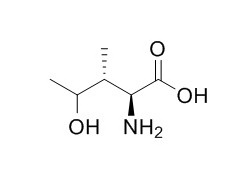L-4-Hydroxyisoleucine
L-4-Hydroxyisoleucine is a natural product from Trigonella foenum-graecum L.
Inquire / Order:
manager@chemfaces.com
Technical Inquiries:
service@chemfaces.com
Tel:
+86-27-84237783
Fax:
+86-27-84254680
Address:
1 Building, No. 83, CheCheng Rd., Wuhan Economic and Technological Development Zone, Wuhan, Hubei 430056, PRC
Providing storage is as stated on the product vial and the vial is kept tightly sealed, the product can be stored for up to
24 months(2-8C).
Wherever possible, you should prepare and use solutions on the same day. However, if you need to make up stock solutions in advance, we recommend that you store the solution as aliquots in tightly sealed vials at -20C. Generally, these will be useable for up to two weeks. Before use, and prior to opening the vial we recommend that you allow your product to equilibrate to room temperature for at least 1 hour.
Need more advice on solubility, usage and handling? Please email to: service@chemfaces.com
The packaging of the product may have turned upside down during transportation, resulting in the natural compounds adhering to the neck or cap of the vial. take the vial out of its packaging and gently shake to let the compounds fall to the bottom of the vial. for liquid products, centrifuge at 200-500 RPM to gather the liquid at the bottom of the vial. try to avoid loss or contamination during handling.
Antimicrob Agents Chemother.2020, AAC.01921-20.
Sichuan Agricultural University2023, 4630743.
J Microbiol Biotechnol.2023, 33(10):1317-1328.
J. ISSAAS2023, 29(2):36-51.
Dent Mater J.2020, 39(4):690-695
Life Sci.2022, 311(Pt A):121157.
Kaohsiung J Med Sci.2023, 10.1002/kjm2.12764
Appl. Sci.2020, 10(20), 7323.
Microb Biotechnol.2021, 14(5):2009-2024.
Antibiotics (Basel).2024, 14(1):8.
Related and Featured Products
Microbiologyopen. 2013 Jun;2(3):471-81.
A novel l-isoleucine-4'-dioxygenase and l-isoleucine dihydroxylation cascade in Pantoea ananatis.[Pubmed:
23554367 ]
A unique operon structure has been identified in the genomes of several plant- and insect-associated bacteria. The distinguishing feature of this operon is the presence of tandem hilA and hilB genes encoding dioxygenases belonging to the PF13640 and PF10014 (BsmA) Pfam families, respectively.
METHODS AND RESULTS:
The genes encoding HilA and HilB from Pantoea ananatis AJ13355 were cloned and expressed in Escherichia coli. The culturing of E. coli cells expressing hilA (E. coli-HilA) or both hilA and hilB (E. coli-HilAB) in the presence of l-isoleucine resulted in the conversion of l-isoleucine into two novel biogenic compounds: l-4'-isoleucine and l-4,4'-dihydroxyisoleucine, respectively. In parallel, two novel enzymatic activities were detected in the crude cell lysates of the E. coli-HilA and E. coli-HilAB strains: l-isoleucine, 2-oxoglutarate: oxygen oxidoreductase (4'-hydroxylating) (HilA) and l-4'-hydroxyisoleucine, 2-oxoglutarate: oxygen oxidoreductase (4-hydroxylating) (HilB), respectively. Two hypotheses regarding the physiological significance of C-4(4')-hydroxylation of l-isoleucine in bacteria are also discussed.
CONCLUSIONS:
According to first hypothesis, the l-isoleucine dihydroxylation cascade is involved in synthesis of dipeptide antibiotic in P. ananatis. Another unifying hypothesis is that the C-4(4')-hydroxylation of l-isoleucine in bacteria could result in the synthesis of signal molecules belonging to two classes: 2(5H)-furanones and analogs of N-acyl homoserine lactone.



